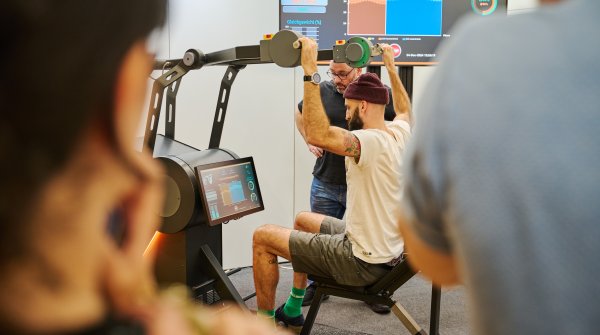
You stayed late at the office yet again. It is pitch black outside and getting pretty chilly. Go for a run now? Maybe not. Exhausted, you recline on the sofa and grab the TV remote. Your lack of willpower has triumphed and destroyed all your great intentions. This is a dangerous situation: lack of physical activity has a negative impact on body and soul.
But we are not impressed, and sit and sit and sit. According to estimates office workers spend about 80,000 hours of their professional lives sitting down. “If you sit for eight hours, your entire body falls into a sort of coma,” sports researcher Ingo Froböse warns.
What can we do? Physical activity has to return to our everyday life and to our workplace. In the future we may be working until we are 67 or even 70 years old, and thus need to remain fit for the remainder of our professional life. Yet this insight seems to create awareness only very slowly, corporate sports activities continue to lead a shadowy existence. Some corporations and businesses, however, already offer prevention and fitness activities, and developed concepts for workplace health promotion programs.
Health and fitness for 400 employees
The concept of the OKE Group in Hörstel near Osnabrück is exemplary. The company hired two sports researchers who manage the health and fitness of its 400 employees. They organize classes ranging from aerobics, Nordic walking, back exercises to Zumba.
The in-house fitness studio with large panoramic windows features stationary bikes, weight benches, cross-trainers and treadmills. Employees wishing to lift weights, run or spin can do so at any time. “We work with an honor system in regards to work hours. We let our employees decide when they want to work and when they want to exercise. The deciding factor is that everyone accomplishes their jobs,” explains health manager Frank Potthoff.
In addition, a physical therapist visits the company twice a week to ease tense muscles, a corporate physician provides stress EKGs and evaluates blood sugar levels if desired. The concept is successful: 90 percent of the employees use “something from our program to increase health,” says Potthoff.
Sick days have decreased considerably. And the company implemented a bonus system to entice sluggish employees to get up from their chairs. An above-average result in a fitness test is rewarded with 100 Euro.
GERT Ages You In Seconds
How can we design workplaces that are comfortable even for older employees and allow them to work effectively? GERT can help. Stefan Sikorsky at Siemens in the Bavarian town of Kemnath frequently dons a gerontologic test suit to find out more. Sikorsky is actually only 27 years old, but GERT ages him by 30 years in seconds. Added weights and bandages deliver more strain, overshoes and gloves simulate aging joints, special glasses and earpieces limit vision and hearing.
The insights gained with the help of GERT (“You tire more quickly; your range of vision is restricted; arms, legs and neck are no longer as mobile.”) are used to help design an age-appropriate workspace. To be able to alter between sitting and standing its height can be adjusted and it can be modified for each individual. Since the range of vision decreases as we age, the workspace should not be wider than 1.50 meters.
Special exercise equipment
Anyone working in Kemnath, wishing to remain fit and mobile for a long time can also benefit from preventative activities: production areas feature integrated exercise islands. Special equipment allows employees to exercise their neck, shoulder and back muscles, fitness trainers are on site to offer introductions and consultations. There are also corporate sports groups and 20 scouts who “consistently promote the theme of workplace health management in our company,” according to a corporate communications spokesperson.
The workforce at Adidas has been involved in sports for many years. They can select from 300 classes like circle training, yoga, climbing, swimming, boxing or dancing, and burn off energy in the morning, at lunchtime or after work. The sporting goods manufacturer opened an almost 4,000-square-meter fitness studio in Herzogenaurach in early 2014.
In addition, employees are invited to participate in ski weekends, bike, golf, and kayak camps, horseback riding excursions in Iceland or sailboat cruises in Croatia. The company created a special workplace health management department in 2012. And founder Adi Dassler always sent his staff to the soccer field to test the company’s new jerseys.
Nothing Works Without Rewards
"I generally appreciate corporate sports as long as they have the right substance,” says Klaus-Michael Braumann, Professor of Sports Medicine at Hamburg University. The focus should be “less on the perfect relay race or soccer tournaments” but rather on the softer side of health management such as fitness gymnastics, yoga or classes teaching relaxation methods, better suitable to our modern working life. “Many companies have an enormous backlog in this respect,” judges Braumann, whose institute consults companies on how to motivate their employees to start a health and fitness routine.
The expert considers small trade workshops in particular “a ticking time bomb”. “The master is generally in his fifties or older. If he gets sick and cannot work the operation breaks down because there is no successor qualified to take over.” Small and medium-sized companies unable to afford their own programs urgently have to become active. They should partner with health insurance companies and other companies, he suggests.
Without a system of rewards the promotion of workplace health and fitness will not work, Braumann agrees. To motivate employees to start exercising it may be beneficial to offer cholesterol or blood pressure checks at the office. “Most people don’t know their own values. If you confront someone with a cholesterol level of 280 and blood pressure of 160, he’ll start wondering what the reasons are and become concerned enough to start exercising.”
He suggests that a “small reward” like an extra day of vacation for improving these values may help entice the employee to stay the course. “I believe that the only thing that tops human sluggishness is greed.”
Managing employee health is also of benefit to the companies themselves, and in more than one way. “Today, close to 28 percent of our workforce retire early due to health reasons. They are on average 55 years old. A trend that will continue to come to a head in the coming years,” according to a study by Roland Berger, a corporate consulting firm. Illness-related workforce losses cost German companies close to 60 billion Euro per year.
Health programs ensure performance
Corporate health programs, however, ensure workforce performance: thanks to working conditions with reduced stress and the appropriate healthcare it should be possible to reduce workforce losses by up to 40 percent, according to Roland Berger.
Finnish research has gone even further: while the work capacity of employees between the ages of 55 and 65 undergoes a significant decline without supportive measures, it can even experience a long-term improvement. “The problem is the work – and not the age,” Finnish social expert Professor Juhani Ilmarinen sums up the issue.
Motorola, for example, has gained return on investment (ROI) of 3.94 Dollars for every Dollar spent on its health and wellness program. Each Dollar invested in corporate health management returns three to eight Dollars within five years, US scientists discovered.
Add to this the fact that healthy and happy employees tend to stay loyal to their companies longer, as shown by a study performed by management consultant Towers Watson. The rate of job resignations in companies offering health and wellness programs was only nine percent and thus is considerably lower than in other businesses.
Everyone Has To Exercise
If the management doesn’t show interest in sports and activities, employees will likely not be motivated to exercise. Business executives and managers should participate, says Leonard L. Berry. The Professor of Marketing at Mays Business School der Texas A&M University compared the workplace wellness programs of ten companies including SAS Institute, Johnson & Johnson and Chevron and summarized the six pillars for their success. Read more here.
- Awards
- Mountain sports
- Bike
- Fitness
- Health
- ISPO Munich
- Running
- Brands
- Sustainability
- Olympia
- OutDoor
- Promotion
- Sports Business
- Textrends
- Triathlon
- Water sports
- Winter sports
- eSports
- SportsTech
- OutDoor by ISPO
- Heroes
- Transformation
- Sport Fashion
- Urban Culture
- Challenges of a CEO
- Trade fairs
- Sports
- Find the Balance
- Product reviews
- Newsletter Exclusive Area
- Magazine






